The Indigenous people of Canada are considered to be part of the Fourth World because although they are resident in the First World, many are marginalized and live in remote locations1. The Indigenous populations of Canada experience lower health status than members of the dominant society, experiencing a disproportionate burden of morbidity and mortality and having many social, economic and health indicators similar to those in middle-income nations2. In 2001, Canada ranked eighth on the UN's Human Development Index. According to the same index, Canada's Indigenous population ranked 32nd3.
While defining 'water security', the Second World Water Forum (The Hague 2000) emphasised (a) ensuring protection and improvement of freshwater, coastal, and related ecosystems, (b) promotion of sustainable development and political stability, (c) promotion of access to adequate, safe water at an affordable cost for every person, and (d) protection of the vulnerable population from the risks of water-related hazards4. Do such conditions exist in Canada's Indigenous communities?
According to the National Household Survey (2011), approximately 4.3% of Canada's population identify as Indigenous. In Canada, there are three distinct categories of Indigenous people: First Nations, Métis and Inuit, representing 60.8%, 32.3% and 4.2% of the total Indigenous population respectively5. First Nations are defined as the Indian peoples of Canada, both status (recognized as Indians under Canada's Indian Act) and non-status (Indians or members of a First Nation not recognized under the Indian Act). The Métis are the descendants of First Nations people and early Europeans. The word 'Métis' is French for 'mixed blood'. The people of the Canadian Arctic are known as the Inuit. Formerly, they were called Eskimos, which is now considered derogatory6.
In 2011, the Auditor General of Canada said that more than half of the water systems on the lands reserved for Indigenous people posed a medium or high risk of contamination. As of August 2012, almost one out of five First Nations communities in Canada were under water advisories requiring residents to either boil their water or stop drinking it7. Indigenous homes are 90 times more likely to be without a piped water supply3. Water security problems in Indigenous communities are not limited to drinking water quality but extend to drinking water accessibility and the management of wastewater and sewage. According to the Assembly of First Nations, 75% of the 740 water treatment systems and 70% of the 462 wastewater treatment systems on reserves posed risks to drinking water and wastewater quality8.
Water insecurity in Indigenous communities has been associated with the colonial past. Many Indigenous people were subjected to coerced relocations to sites with poor land, few water resources, and/or water resources contaminated by development activities such as agriculture and mining9. Smaller water systems were more prone to contamination from development activities because these took place closer to smaller communities than to large urban centres. Hence, Indigenous people living in smaller and remote communities are more vulnerable10. Indigenous knowledge of water source protection was gradually eroded due to the systematic promotion of natural resources extraction and management based on Western values and approaches8.
Indigenous people intimately connect water with physical and spiritual health and consider water to be the basis of all life. The degradation of water and the environment results in the deterioration of the health and culture of Indigenous people and communities11. Sustainable development in remote areas with little provision for local agencies is difficult to impossible; maintaining or improving conditions is extremely challenging8.
Similar conditions have also been witnessed in the Indigenous communities of other circumpolar regions, such as Alaska (USA). Almost one in four Alaskan Indigenous communities lacks complete plumbing facilities12. In other words, the residents do not have any running water and sanitation facilities. It is interesting to note that, according to the WHO's 2009 report, both Canada and the USA have 100% access to improved water and sanitation despite a dismal record of water security in the Indigenous communities13,14. Despite several reports of inaccessibility of water and poor quality, researchers have not examined how the small and isolated Indigenous communities cope with the perennial problem and encounter multiple health risks. An exploratory study was conducted to determine the water insecurity of a remote Indigenous community and their coping strategies and to find their associated health risks.
Setting
The study was conducted in Black Tickle-Domino, a sub-Arctic Inuit community on the remote Island of Ponds off the coast of southern Labrador (see map, Fig1). The residents in Black Tickle-Domino are the descendants of Inuit women from Labrador and men from the British Isles who came to Labrador to fish and trap in the 18th and 19th centuries. Annual temperatures range from -25°C to +25°C from winter to summer. Snowfall is substantial, covering the ground for almost half of the year. There is no regular connection to mainland Labrador, and there are no longer any commercial flights to the island. The seasonal ferry service operates weekly from around June to November/December, depending on ocean ice conditions. The nearest community, Cartwright, another Inuit community, is a 2.5-hour snowmobile ride away. Due to Black Tickle-Domino's remote location, there is no power transmission line, resulting in a complete reliance on expensive diesel power for home heating, although wood is also used15-17.
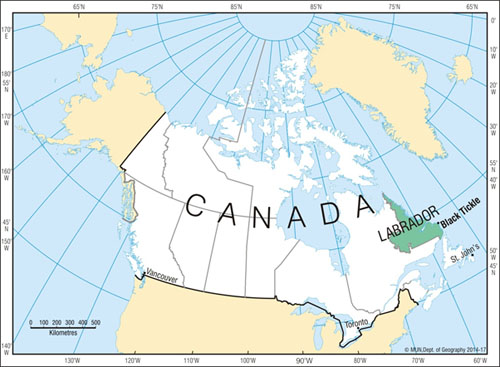
Figure 1: Black Tickle-Domino in Labrador.
A case-study approach was employed that focused on Black Tickle-Domino, using mainly qualitative but also some quantitative methods. Health and wellbeing of the Indigenous society were considered a culturally sensitive issue, and so the community leaders suggested avoiding individual interviews of the population except key informants (KIs) selected by systematic sampling. Research is still considered a 'dirty word' in the Indigenous community. After consultations with the regional health authority and community leaders, convenience sampling was followed and participatory research approach was adapted as prescribed by the Canadian Institute of Health Research Guidelines (Article 3) for Health Research Involving Aboriginal People18. For demographic (very low), habitat (remote location) and socio-cultural factors, the convenience sampling is the most effective method in Indigenous health research in Canada19.
The authors travelled by chartered flight to visit Black Tickle-Domino in April 2013 and October 2013. In the first visit, the official administration of the community and the Family Resource Centre were contacted to reach out to all the households to seek their participation in focus group discussions (FGDs) and face-to-face KI interviews. It was a convenience sample, since the subjects (of FGDs) were self-selected and volunteered to participate. However, some KIs (number of participants in parentheses), such as community leader (1), woman (1), community nurse (1), teacher (1), and elder (1), were also individually approached for in-depth, open-ended interviews. According to the spring 2013 census, the year-round population was only 138. Since the total population of the community was very low, there was no option for systematic sampling for KIs.
Four FGDs were carried out (number of participants in parentheses): women's group (5), high school students (8), community members (25), and community leaders (5). In these discussions, the emerging themes of water availability, water use patterns, water quality, perceived health risks due to water insecurity, and coping strategies were focused on. This approach allowed residents' perspectives to be presented as articulated and prioritized by them, thus more closely reflecting Indigenous world views. The data were primarily qualitative in nature. The total number of adult and adolescent (high school students) participants in FGDs and interviews represented almost 37% and 100% of the total population subgroups, respectively. Each FGD and KI interview continued for 45 minutes to 1 hour. In the KI interviews, apart from general questions on water insecurity and coping strategies, a few questions were asked specific to the KI's background, such as water governance (community leader), gender issue (woman), community health (nurse), health and hygiene awareness among the students (teacher), and traditional beliefs and practices (elder). All the interviews and discussions were audio recorded and transcribed for analysis.
After a long history of misuse and abuse of Indigenous peoples and knowledge by Western researchers, conducting research in Indigenous contexts is a challenging prospect20. However, the Indigenous background of some of the team members helped reach out to the community without facing any objection. In fact, some community members facilitated the initial dialogue with the participants.
All the major water sources (wells, brooks, ponds, and public water) were tested for microbiological contaminations (E. coli) (by the provincial public health laboratory at Happy Valley-Goose Bay, Labrador), metals and minerals (by the Laboratory of Memorial University of Newfoundland) and hydrocarbons (by Maxxam, a private accredited laboratory of St John's), and the past reports of public water (Black Tickle-Domino) from the provincial government website (Department of Environment and Conservation, Newfoundland and Labrador) were also analyzed21. The microbiological testing was conducted in April (5) and October (7) to check for any seasonal variations of microbial contamination (coliforms). Two wells were buried under snow in April and hence water from those wells could only be tested in October. Hydrocarbons were tested to check any contamination of the water sources by oil leakage from snowmobiles and all-terrain vehicles (ATVs). A walk-through survey (observational) was also conducted to find out the conditions of waste disposal (solid waste and human waste) of the areas surrounding the individual water sources. Due to difficult terrain and long distance, snowmobile and ATVs were used for the walk-through survey.
An experienced professional transcribed the audio records. NVivo v9 software (QSR International; www.qsrinternational.com) was used for analysis of the transcribed (qualitative) data. There were several common questions and responses in different FGDs and KI interviews. The entire qualitative (FGDs, KI interviews and walk-through survey) and quantitative (water quality report) records were broadly divided into (a) water sources, access and quality, (b) coping, (c) perceived health risks, and (d) challenges to run public water system.
Ethics approval
The Health Research Ethics Authority of Newfoundland and Labrador approved this study in 2012 (No. 12.136). It was also approved by the NunatuKavut Community Council and the Labrador-Grenfell Health Authority. Each participant signed a consent form before interview or discussion. Parents of the high school students signed the respective consent forms before allowing their children to participate in a group discussion. Prior to the signature, printed brief background information about the research was provided, which included the purpose of data collection and how the research would benefit the community. Before ethics approval, all the researchers had to undertake online training conducted by the federal research agency (Tri-Council). This was mandatory before conducting any research in the Indigenous community.
Water sources, access and quality
There was no piped water system or water truck. The regular sources of water were several unmonitored local streams in the community, brooks, and ponds (Figs2-5). Since 2004, the community has had a potable drinking water unit (PDWU) selling water for C$2 per litre. The PDWU was irregularly funded by the provincial government. Bottled water was not always available for purchase at two local stores.
The PWDU was located almost 2 km from the furthest house in Black Tickle-Domino and about 1 km from the nearest house. The PWDU extracted raw water from Herring Cove Pond, located 2 km from Black Tickle, and it conducted a series of treatments (triple chlorination, multimedia filtration, and reverse osmosis) before selling to the public. There was also a free tap outside the PWDU. The free water was chlorinated once and was only meant for washing and cleaning. But often people collected water from that tap for drinking and cooking as well. Besides the cost of water, location was also a major obstacle to regular PDWU use, due to high transportation costs, eg snowmobile gas. Hostile weather, especially heavy snowfalls and storms, was a major barrier to water retrieval from a favoured brook, around 25 km away. Local shallow water pits ('wells') emerged as the water sources; although, in winter and spring, some wells became inaccessible, being buried under snow.
As regards water quality, the wells were vulnerable to contamination by wild animals' feces and urine. Water quality testing showed the presence of E. coli in two sources out of seven, all tested in the fall. As per government policy, the report did not mention the actual count of E. coli (either 'present' or 'absent'). Hydrocarbons (benzene, toluene, ethylbenzene, xylene, C6-10, C11-16, C17-21, C22-31) were tested for, but all the parameters were below detectable limits. There was no report of high levels of hazardous metals and other minerals in any water samples. Many community members did not trust the PDWU due to longstanding attachments to the brook, the high cost of purchasing water, and the frequent breakdowns and closure periods when provincial government funding was unavailable. There also was mistrust in the PDWU site because of animal activity, especially muskrat and beaver in and around the source pond. Government reports show a high level of disinfection by-products (DBPs), ie trihalomethanes (THM) and haloacetic acids (HAA) in one of the taps (outside the PDWU and free). A report from spring 2008 to fall 2014 showed that out of 18 samples tested, eight (44%) had HAA above the guideline value of 80 µg/L. The range of high levels and overall average were 82-452 µg/L and 112 µg/L respectively. Another report from summer 2002 to fall 2014 showed that out of 28 samples tested, 11 (39%) had THM above the guideline value of 100 µg/L. The range of high levels and overall average were 113-460 µg/L and 101 µg/L respectively. The presence of DBPs, known for carcinogenic properties, indicates inefficiency in removing natural organic materials from the water before chlorination22. The potable water samples (properly filtered) of PDWU were either free from DBPs or below guideline values.
In most years, during winter, snow cover enabled the residents to use snowmobiles and komatiks (Inuit sleds) to retrieve water. Winter was the season of greatest mobility and thus, the least difficult time to collect water. Post-winter and early winter were very challenging times for water transportation as there was insufficient snow cover for snowmobiles yet there was too much snow for travel by ATVs. At times, extreme weather restricted outdoor movements for up to several days. Mechanical problems with snowmobiles and ATVs affected water collection. Some households did not own an ATV or a snowmobile but there was extensive culturally reinforced sharing, thus offering some protection to more vulnerable community members, such as lone parents. Residents without such vehicles shared fuel costs. Komatiks could hold total 14 five-gallon buckets (total 265 L) of water (Fig6) while tow carts attached to ATVs could carry 23 buckets (total 350 L). Water retrieval was labour-intensive because of the distance and the physical effort required to load, move and unload water. So, several households were limited to one trip per day. A crude estimation of per day per capita water usage was 90 L.
In addition to the costs of water already identified, there were other substantial costs associated with water acquisition, such as komatik and tow-cart maintenance of holding tanks, boiling and filters. With the majority of the population depending on government transfers, these costs were difficult to meet, adding further burden to peoples' quality of life. Widespread poverty limited the ability of most households to purchase bottled water, to boil water in their homes or to buy drinking water from the PDWU, which, in any case, was irregularly funded and operational. Free but unmonitored and untreated water from the wells remained the best option from the perspective of household finances. Due to the lack of a piped septic system, human waste was carried on the same komatiks used for water retrieval and then dumped in the harbor or the designated landfill site.
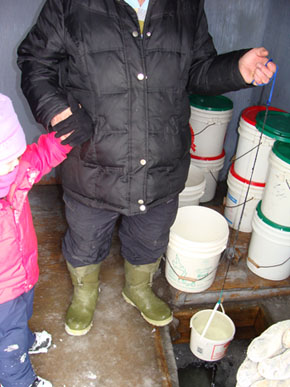
Figure 2: Retrieving water from a 'well' in Black Tickle. The 'well' is essentially a shallow collection pit, dug in a stream that brings water from an adjacent hill.
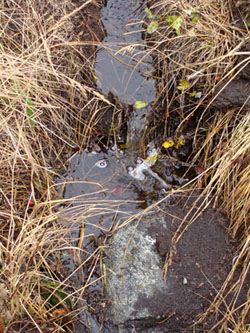
Figure 3: A bog, one of the major sources of drinking water. The brownish color of the water is due to the presence of organic matter. The water often gets contaminated by animal feces.
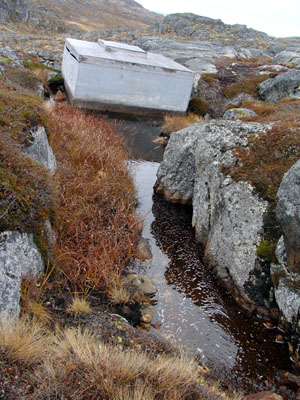
Figure 4: Bog water before reaching the well. In winter, the well gets covered with thick snow, enabling water collection only during the summer.
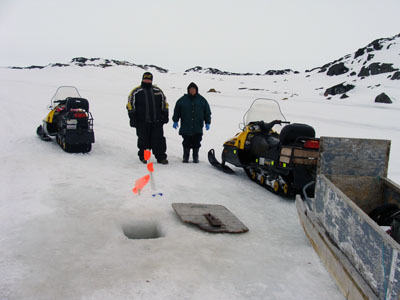
Figure 5: Herring Cove Pond, another source of drinking water. The piece of wood is used to cover the hole.

Figure 6: A total of 14 buckets of water for daily use for a family of three or four members.
Coping
Virtually every household tried to conserve water, especially if a winter storm was imminent or when wells dried up in summer. Stacks of salt-beef buckets were observed in almost all visited houses. One woman said she drank one cup of coffee per day and one glass of water, having 'no other choice'. Another said, 'No one is drinking enough water in the community', with all other focus group participants agreeing. Several residents with diabetes and other chronic illnesses reported that they reluctantly restricted their water intake.
Recycling water also was widespread; bath or shower water was used for washing out waste containers. Sometimes bath or shower water was also shared, such as children bathing together and then the same water being used by their parents. To make water more palatable or to mask water with a brown cast (due to the high iron content or natural organic materials), parents offered Kool-AidTM (non-nutritious processed drink) or a bottle of high-sugar-containing pop (PepsiTM/Coca-ColaTM). High-sugar beverages cost 15 cents less than a bottle of water at the local store, and they were more consistently available. So the choice was made to consume high-sugar beverages, although residents expressed serious concern about the negative effects of high-sugar consumption on health.
Perceived health risks
The FGDs and KI interviews revealed that gastro-intestinal infections were the most common disease in the community. In the fall of 2012, there was an outbreak of infection transmission continuing until late 2012. According to the community nurse, its duration was longer than all previous episodes and every household and almost all people were affected.
Official statistics are not available for communities as small as Black Tickle-Domino, but there appeared to be a high prevalence of type 2 diabetes. Several community members talked about several families with multiple cases of type 2 diabetes, all being under regular medication. Despite medical advice to have a high water intake, many diabetes patients could not afford to follow this advice.
Given the physical demands of water retrieval, study participants reported that virtually every man in the community had chronic pain due to back and shoulder injuries (Fig7). Some men required surgery, but they indefinitely postponed it due to the unavailability of alternative persons to retrieve water for their families.
Mental stress was also associated with water insecurity in the community. Water was always on peoples' minds, especially before storms; hence, despite their knowledge of the potential health risks, people consumed untreated water and unhealthy high-sugar drinks. The residents understood about the linkages between water insecurity and high rates of obesity, and they regretted their high-sugar intake, but they expressed a sense of helplessness. One woman explained:
I gave up diet drinks over a year ago and I was doing very well but then we [the community] ran out of water and when I had to drink water at $1.25 a bottle and I needed four [bottles] a day - there was no water available from the treatment plant [PDWU] - well, I couldn't get fresh or clean water - I couldn't afford to buy four bottles of water a day just for me. Pepsi was all that was available and Pepsi was cheaper, so I went back on it. The boiled water is disgusting; it tastes disgusting. Pepsi is $1.10 compared to water, which is $1.25.
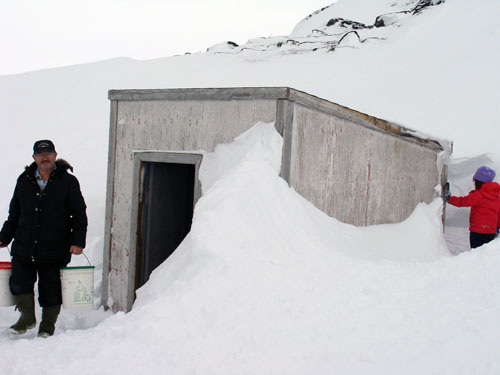
Figure 7: Carrying water is men's work. The majority of men in the community suffer from chronic muscular-skeletal injuries with no respite.
Managing the public water system
The challenges of operating the PDWU began soon after the installation in 2004 when it became apparent that funding was inadequate. Its annual operating cost was approximately $30,000, but there was no funding in 2012. Consequently, volunteers began to run the system, but soon they encountered mechanical failures, and the chlorine supplies ran out. Fortunately, a newly elected Local Service District received a grant of approximately $30,000 in 2013 to operate the site and it was able to rehire the operator for the next year. Currently, the town had a pending $2000 power bill, and it received cut-off notices from the power company (a provincial crown corporation). Operating the PWDU seemed unsustainable even with the user fee ($2/L), given the high rate of unemployment and poverty.
Discussion
This case study of one of Canada's remote Indigenous communities has provided a multidimensional picture of the dynamics of water insecurity and population vulnerability. While the community did not have any piped water supply, their regular unprotected water sources had animal fecal contamination. Treated public water was not affordable to the majority of community members and free public water had disinfection by-products. The community expressed how water insecurity is causing an infectious outbreak, mental stress and muscular-skeletal injuries. The residents managed the perennial water problem by conservation and recycling of water at home, reducing its intake and drinking high-sugar beverages as the alternative. But the coping strategies put personal hygiene and future health at risk. Residents used approximately one-third of the Canadian average of 274 L water/day/person23. In Canada, about one-third of water usage was for toilets24 and this figure pointed to the lack of sanitation practices in Indigenous communities such as Black Tickle-Domino. According to the WHO standard, travelling more than 100 metres to access water puts the health risk of community members between high and very high25.
Despite economic hardship and mobility issues, community support and sharing allowed the most vulnerable population access to water. Another recent study in Labrador showed that physical health and access to transportation by ownership, sharing fuel cost or social bonds were the important factors determining water access26.
Water insecurity has not only put Indigenous communities at risk of water-borne infections, but it has also made them vulnerable to other serious adverse health outcomes, such as obesity, diabetes, gastritis and stomach cancer and influenza. Obesity and diabetes among Canada's Indigenous populations have reached epidemic proportions. The prevalence of obesity is particularly high among First Nations people: 32% of adult men, 41% of adult women, 14% of youth and 36% of children are considered obese27. The overall obesity rate among First Nations (36%), Métis (26%) and Inuit (24%) is higher than that of non-Indigenous people (17%)28. Age-standardized rates show the prevalence of diabetes to be 17% among First Nations and 7% among Métis, compared to 5% in the non-Indigenous population. Indigenous individuals are often diagnosed at a younger age, and complications such as renal diseases are more frequent than among the non-Indigenous population29. The high rate of diabetes among Indigenous people is the main contributing factor to the rising rates of chronic kidney disease30. A diet high in sugar is considered to be one of the reasons for the rising trend of obesity and diabetes. But none of the scientific reports has mentioned the possible roles of water insecurity as an important modifying factor for changing diet. This case study, however, shows water insecurity and poverty have resulted in a high intake of cheap sugary beverages as an alternative to water, particularly among children. Further in-depth studies will be needed to establish the causal pathways of water insecurity, high intake of sugary water and adverse health impacts. Water insecurity has also prevented people with diabetes from receiving an adequate intake of fluids, which makes them potentially vulnerable to related complications.
Helicobacter pylori infection is one of the risk factors for gastritis and stomach cancer, with studies showing that it may spread most readily through either vomiting or diarrhea during acute gastroenteritis caused by other agents. Poor water and sanitation are believed to be the main reason for very high prevalence of H. pylori infection in Canadian and other Arctic Indigenous populations31,32. Not surprisingly, a recent systematic review shows a very high burden of stomach cancer in Indigenous populations; the incidence and mortality rates are up to fivefold that of non-Indigenous populations and the incidence appears to be increasing in several Indigenous populations. Poor sanitation and H. pylori infection are blamed for this scenario33.
In 2009, when the H1N1 influenza pandemic hit Canada, there were disproportionate effects in many Indigenous communities34. Recommended infection control measures such as frequent hand washing was impossible in communities such as Black Tickle-Domino.
Water insecurity in Black Tickle-Domino constitutes violations of (a) Canada's constitutional obligations to First Nations, Inuit and Métis35, and (b) United Nations resolution (No. 64/292, dated 28 July 2010) of the human right to water and sanitation36. It is ironic that Canadians are the world's second-largest per capita users of water while its own Indigenous citizens are deprived of basic water and sanitation facilities. In 2014, Black Tickle-Domino drew media attention for the further deterioration of its water security. After the collapse of the PDWU, residents resorted to collecting water from local ponds and drain-off ditches37. In spring 2015, the Canadian Red Cross had to fly in supplies of bottled water due to repair work of the PDWU38.
The major limitation of the study was the low population of the community. Due to limited resources, more such remote Indigenous communities in Labrador could not be included. However, it has given a unique picture of the dynamics of water insecurity, risks and community and individual responses. It is expected that this research will be extended at the national level for more in-depth information. It is often argued that the establishment of any fully functioning public water systems in small remote communities is relatively expensive. These findings show that water insecurity in remote Indigenous communities can result in multidimensional consequences, including adverse health, economic, social and cultural impacts. Therefore, a regular supply of affordable, safe drinking water would have far-reaching benefits to the communities.
Acknowledgements
The authors would like to thank the people of Black Tickle-Domino, the Black Tickle-Domino Local Service District, NunatuKavut Community Council, Labrador-Grenfell Health Authority, the Health Research Unit, Faculty of Medicine, Memorial University, and the funders, the Harris Centre/RBC Water Fund, the Labrador Institute, and the Office of the President of Memorial University. The authors are grateful to Dr Victor Maddalena and Dr Iain Robbé for comments and suggestions.
References
1. O'Neill JD. The politics of health in the fourth world: a northern Canadian example. Human Organization 1986; 45: 119-128.
2. Ford JD, Berrang-Ford L, King M, Furgal C. Vulnerability of Aboriginal health systems in Canada to climate change. Global Environmental Change 2010; 2: 668-680.
3. The Department of Economic and Social Affairs, United Nations. State of the world's Indigenous peoples. New York: United Nations, 2009. Available: www.un.org/esa/socdev/unpfii/documents/SOWIP/en/SOWIP_web.pdf (Accessed 25 October 2014).
4. WWC. Declaration of The Hague: Ministerial declaration of The Hague on water security in the 21st century. The Hague: Second World Water Forum, World Water Council, 2000. Available: www.worldwatercouncil.org/fileadmin/world_water_council/documents/world_water_forum_2/The_Hague_Declaration.pdf (Accessed 25 October 2014).
5. Statistics Canada. Aboriginal Peoples in Canada: First Nations People, Métis and Inuit. (Online) 2014. Available: www12.statcan.gc.ca/nhs-enm/2011/as-sa/99-011-x/99-011-x2011001-eng.cfm#bx6 (Accessed 15 October 2014).
6. Government of Ontario. Aboriginal glossary of terms. (Online) 2012. Available: www.ontario.ca/aboriginal/aboriginal-glossary-terms (Accessed 25 October 2014).
7. Office of the Auditor General of Canada. The 2011 status report of the Auditor General of Canada to the House of Commons - Chapter 4: Programs for First Nations on reserves. (Online) 2011. Available: www.oag-bvg.gc.ca/internet/docs/parl_oag_201106_04_e.pdf (Accessed 19 October 2014).
8. White JP, Murphy L, Spence N. Water and Indigenous peoples: Canada's paradox. International Indigenous Policy Journal 3. (Online) 2012. Available: http://ir.lib.uwo.ca/iipj/vol3/iss3/3 (Accessed 23 October 2014).
9. Aboriginal Affairs and Northern Development Canada. Highlights from the Report of the Royal Commission on Aboriginal Peoples. (Online) 1996. Available: www.aadnc-aandc.gc.ca/eng/1100100014597#chp3 (Accessed 19 October 2014).
10. Reading J, Perron D, Marsden N, Edgar R (Eds). Crisis on tap: seeking solutions for safe water for Indigenous peoples. University of Victoria, BC; Centre for Aboriginal Health Research, 2010.
11. Environment Canada. Water and Canada's Aboriginal peoples. (Online) 2010 Available: www.ec.gc.ca/eau-water/default.asp?lang=En&n=BA5125BF-1 (Accessed 19 October 2014).
12. Gasteyer S, Vaswani RT. Still living without the basics in the 21st century: analyzing the availability of water and sanitation services in the United States. Rural Community Assistance Partnership. (Online) 2004. Available: www.win-water.org/reports/RCAP_full_final.pdf (Accessed 23 October 2014).
13. WHO. Country profile of environmental burden of diseases (Canada). World Health Organization; (Online) 2009. Available: www.who.int/quantifying_ehimpacts/national/countryprofile/canada.pdf (Accessed 23 October 2014).
14. WHO. Country profile of environmental burden of diseases (USA). World Health Organization; (Online) 2009. Available: www.who.int/quantifying_ehimpacts/national/countryprofile/unitedstatesofamerica.pdf?ua=1 (Accessed 23 October 2014).
15. Community Accounts. Black Tickle-Domino profiles. Government of Newfoundland and Labrador. Available: http://nl.communityaccounts.ca/profiles.asp?_=vb7En4WVgaauzXVr (Accessed 14 August 2015).
16. Heritage - Newfoundland and Labrador. Labrador's Inuit-Metis: the historical background. Available: www.heritage.nf.ca/articles/aboriginal/metis.php (Accessed 14 August 2015).
17. Memorial University of Newfoundland. Understanding the past to build the future. (Online) 2012. Available: www.mun.ca/labmetis (Accessed 14 August 2015).
18. Canadian Institute of Health Research. CIHR guidelines for health research involving Aboriginal people. (Online) 2013. Available: www.cihr-irsc.gc.ca/e/29134.html (Accessed 6 October 2014).
19. National Aboriginal Health Organization. Convenience sampling - the Metis Health Research Database. Available: www.metiscentreresearch.ca/fr/taxonomy/term/1497 (Accessed 14 August 2015).
20. Lowan-Trudeau G. Methodological métissage: an interpretive Indigenous approach to environmental education research. Canadian Journal of Environmental Education 2012; 17: 113-130.
21. Government of Newfoundland and Labrador. Water resources portal (Black Tickle-Domino). (Online) 2014. Available: http://maps.gov.nl.ca/water/reports/viewreport.aspx?COMMUNITY_NAME=Black%20Tickle-Domino (Accessed 23 October 2014).
22. Department of Environment and Conservation, Water Resources Management Division, Government of Newfoundland and Labrador. Best management practices for the control of disinfection by-products in drinking water systems in Newfoundland and Labrador. St John's, NL: Government of Newfoundland and Labrador, 2009.
23. Environment Canada. 2011 municipal water use report. Municipal water use 2009 statistics. Government of Canada Report. (Online) 2011. Available: www.ec.gc.ca/Publications/B77CE4D0-80D4-4FEB-AFFA-0201BE6FB37B/2011-Municipal-Water-Use-Report-2009-Stats_Eng.pdf (Accessed 18 October 2014).
24. Canadian Geographic magazine. Canadian water use - a wretched excess? (Online) 2000. Available: www.canadiangeographic.ca/magazine/mj00/water_use.asp (Accessed 21 October 2014).
25. World Health Organization. Guidelines for drinking-water quality. Vol. 1. Recommendations 3rd edn, incorporating first and second agenda. Geneva: World Health Organization, 2008. Available: www.who.int/water_sanitation_health/dwq/gdwq3rev/en (Accessed 24 October 2014).
26. Goldhar C, Bell T, Wolf J. Rethinking existing approaches to water security in remote communities: an analysis of two drinking water systems in Nunatsiavut, Labrador, Canada. Water Alternative 2013; 6: 462-486.
27. Public Health Agency of Canada. Obesity in Canada - snapshot. (Online) 2012. Available: www.phac-aspc.gc.ca/publicat/2009/oc/index-eng.php#footnote10 (Accessed 24 October 2014).
28. Public Health Agency of Canada. Obesity in Canada - prevalence among Aboriginal populations. (Online) 2011. Available: www.phac-aspc.gc.ca/hp-ps/hl-mvs/oic-oac/abo-aut-eng.php (Accessed 24 October 2014).
29. Public Health Agency of Canada. Diabetes in Canada: facts and figures from a public health perspective. (Online) 2011. Available: www.phac-aspc.gc.ca/cd-mc/publications/diabetes-diabete/facts-figures-faits-chiffres-2011/highlights-saillants-eng.php#chp6 (Accessed 24 October 2014).
30. Yeates K, Tonelli M. Chronic kidney disease among Aboriginal people living in Canada. Clinical Nephrology 2010; Suppl 1: S57-60.
31. Goodman K, Jacobson K, Veldhuyzen ZS. Helicobacter pylori infection in Canadian and related Arctic Aboriginal populations. Canadian Journal of Gastroenterology 2008; 22: 289-295.
32. McKeown I, Orr P, Macdonald S, Kabani A, Brown R, Coghlan G et al. Helicobacter pylori in the Canadian arctic: seroprevalence and detection in community water samples. American Journal of Gastroenterology 1999; 94: 1823-1829.
33. Arnold M, Moore SP, Hassler S, Ellison-Loschmann L, Forman D, Bray F. The burden of stomach cancer in indigenous populations: a systematic review and global assessment. Gut 2014; 63: 64-71.
34. Richardson KL, Driedger MS, Pizzi NJ, Wu J, Moghadas SM. Indigenous populations health protection: a Canadian perspective. BMC Public Health 2012; 12: 1098.
35. Boyd DR. No taps, no toilets: First Nations and the constitutional rights to water in Canada. McGill Law Journal 2011; 57: 1.
36. United Nations Department of Economic and Social affairs. The human right to water and sanitation (Online). 2010. Available: www.un.org/waterforlifedecade/human_right_to_water.shtml (Accessed 21 October 2014).
37. Canadian Broadcasting Corporation. Black Tickle residents drinking bog water, Lisa Dempster says. CBC/Radio Canada. (Online) 2014. Available: www.cbc.ca/news/canada/newfoundland-labrador/black-tickle-residents-drinking-bog-water-lisa-dempster-says-1.2636271 (Accessed 14 August 2015).
38. Canadian Broadcasting Corporation. Red Cross flying bottled water in to Black Tickle. CBC/Radio Canada. (Online) 2015. Available: www.cbc.ca/news/canada/newfoundland-labrador/red-cross-flying-bottled-water-in-to-black-tickle-1.3037081 (Accessed 14 August 2015).


